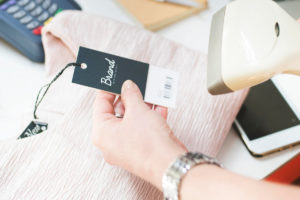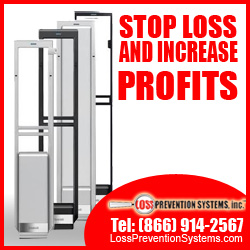I began this series relating a discussion I had with my son about what his role should be in order to stop shoplifting at his new job since he is only a sales associate. It came about I had asked him if he had any encounters with potential thieves as he works in the shoe department of this clothing chain. After telling me about a suspicious incident in which a customer may have stolen an expensive pair of shoes I told him what he can do in the future to help prevent a similar occurrence. I continued the article mentioning that in my former role as a Loss Prevention Manager for over 11 years I trained employees on how to place electronic article surveillance tags like the Sensormatic hard tags. I also trained employee on how to respond properly to electronic article surveillance alarms. My duties also included investigating employee theft cases and apprehending shoplifters. My general tip to my son and other retail employees is they should not be expected to be experts in identifying a shoplifter. They should however have a sense of when someone is suspicious and indicators to look for that would suggest it would be a good idea to notify a manager or Loss Prevention. They should also be ensuring that if the store uses electronic article surveillance devices they have an obligation to ensure merchandise is properly protected.
Identifying suspicious people is not always easy to do. Sometimes there are behaviors that are suspicious and other times it may be the attire someone is wearing that may be suspicious. What is never acceptable and I warned my Loss Prevention Associates about NOT doing this is to base a suspicion on physical characteristics such as age or race. In my training I would use the following as tips for employees to determine if a shopper might be suspicious and help stop shoplifting:
• Unseasonable clothing. If a person is wearing a heavy coat and the temperature outside does not warrant it that person should be given extra customer service.
• Carrying a Large tote or handbag into the store that appears to be empty. Give that shopper a bit of extra attention and if the bag starts to appear fuller as they shop, become even more helpful.
• When a person enters the store with a ball cap pulled down low and especially if wearing sunglasses into the store and not removing them, give extra attention to that person. They are probably trying to conceal their face from cameras.
• This one is going to seem contrary to what a shoplifter would do but it was part of my talk with my son. If a customer seems TOO chatty and not about the products you are showing them, be suspicious. Sometimes it is a method used by thieves to try to gain the trust of an employee and I have even had a Loss Prevention officer of mine fooled by this tactic.
• There is also the shopper who is quick to avoid ANY interaction with an associate. They don’t want any help, they stand in corners and out of the main traffic areas and they look around more than they look at the merchandise. They might be trying to find a way to remove Sensormatic hard tags or other anti-theft devices.
These are just a few tips from my experiences and training I received and provided. I would like to point out that at no time do I tell you that you or your staff should accuse or even suggest someone is trying to steal. Every customer should be greeted in a warm and welcoming manner and offered assistance, it is the right thing to do and it will improve sales. If any of the situations above take place then EXTRA customer service should be offered to stop shoplifting. Spend more time around the customer, engage them in conversation and give them little opportunity to conceal anything. Always be pleasant. The shoplifters tend to get vocal and start to make accusations of harassment but you can always fall back to the fact that you were strictly providing customer service.
These are a few suggestions to get you started but this is not all encompassing. Loss Prevention Systems, Inc. has more information on Sensormatic hard tags and security systems and how they can improve sales and profit. They also have training opportunities on how to prevent shoplifting and even employee theft. There are blogs, newsletters and videos filled with informative tips and tricks to help you improve and grow your business. You and your employees can stop shoplifting without ever placing anyone in a position of having to accuse a person of trying to steal and that keeps everyone safe.
For more information about how to stop shoplifting contact us or call 1.770.426.0547


 Wow, Christmas is over and Retailers are starting to dig out from the carnage. Unfortunately, some of the carnage is all the merchandise that shoplifters have liberated from your store. I believe that theft is actually the oldest vice around. Even older than “the oldest profession”. As long are there are two things on this earth 1-people and 2-stuff, there will be theft. Well, neither is going away anytime soon. So what do we do?
Wow, Christmas is over and Retailers are starting to dig out from the carnage. Unfortunately, some of the carnage is all the merchandise that shoplifters have liberated from your store. I believe that theft is actually the oldest vice around. Even older than “the oldest profession”. As long are there are two things on this earth 1-people and 2-stuff, there will be theft. Well, neither is going away anytime soon. So what do we do?  It’s 2019 and time to make some New Year’s resolutions! We all know how easy a resolution can be to make but they are hard to keep. We also know that it is just as easy to break a resolution but are there resolutions a store owner can make that would benefit the store AND benefit society? I think one resolution that would be mutually beneficial for both would be the implementation of environment-friendly policies and procedures. We are talking about sensible measures that would appeal to anyone on either side of the political spectrum. Right now there is a big push for the elimination of plastic shopping bags. There are also those opposed to going back to paper bags. What could the solution be? Try encouraging the use of recyclable, reusable shopping bags for your customers. You make those opposed to one-time use bags happy and you save money on the need to regularly purchase more shopping bags (which can be a rather pricey supply on your monthly expense report). To implement this type of change you would want to have reusable bags ready for your customers and you might even give them away for the first few weeks you start the program. After that, you might give customers a small discount to customers who bring their own bags, say 1% on every transaction.
It’s 2019 and time to make some New Year’s resolutions! We all know how easy a resolution can be to make but they are hard to keep. We also know that it is just as easy to break a resolution but are there resolutions a store owner can make that would benefit the store AND benefit society? I think one resolution that would be mutually beneficial for both would be the implementation of environment-friendly policies and procedures. We are talking about sensible measures that would appeal to anyone on either side of the political spectrum. Right now there is a big push for the elimination of plastic shopping bags. There are also those opposed to going back to paper bags. What could the solution be? Try encouraging the use of recyclable, reusable shopping bags for your customers. You make those opposed to one-time use bags happy and you save money on the need to regularly purchase more shopping bags (which can be a rather pricey supply on your monthly expense report). To implement this type of change you would want to have reusable bags ready for your customers and you might even give them away for the first few weeks you start the program. After that, you might give customers a small discount to customers who bring their own bags, say 1% on every transaction. For a loss prevention officer, the holiday season is a hard time to be jolly when the busiest shopping season of the year brings with it its shoplifters, crime, and theft.
For a loss prevention officer, the holiday season is a hard time to be jolly when the busiest shopping season of the year brings with it its shoplifters, crime, and theft. Black Friday and the holiday shopping weekend has generally been the time of the year that most retailers are excited about. This is the time when shoppers are going to pull out their wallets and spend money. Deep discounts, doorbusters, even gift bags for the first customers, have been used to entice shoppers to visit stores early. It has been so successful as a marketing tool that stores have even advertised early Black Friday sales in JULY! Unfortunately, it seems that there has been a dark cloud overshadowing this weekend and it is more ominous each year. This cloud is one that can turn a Black Friday into a Bleak Friday if a store owner isn’t prepared for it.
Black Friday and the holiday shopping weekend has generally been the time of the year that most retailers are excited about. This is the time when shoppers are going to pull out their wallets and spend money. Deep discounts, doorbusters, even gift bags for the first customers, have been used to entice shoppers to visit stores early. It has been so successful as a marketing tool that stores have even advertised early Black Friday sales in JULY! Unfortunately, it seems that there has been a dark cloud overshadowing this weekend and it is more ominous each year. This cloud is one that can turn a Black Friday into a Bleak Friday if a store owner isn’t prepared for it. NO! not yet. Before we begin patting ourselves on the back you must remember that your Sensormatic System is only part of your shoplifting solution. Your Sensormatic System will protect your merchandise however, many shoplifters are determined and will try to steal anyway. The Sensormatic System itself is a deterrent. Its mere presence will dissuade many shoplifters.
NO! not yet. Before we begin patting ourselves on the back you must remember that your Sensormatic System is only part of your shoplifting solution. Your Sensormatic System will protect your merchandise however, many shoplifters are determined and will try to steal anyway. The Sensormatic System itself is a deterrent. Its mere presence will dissuade many shoplifters.
